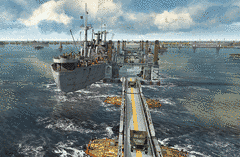06 June 2014
The invasion of Normandy recreate in 3D and in VR
Today, in 1944, one of the crucial event that brought to the world as we know it today took place. Seventy years ago, at 6:30 in the morning, the invasion of Normandy begun with a massive and costly landing operation on the shores of France.
The D-Day which changed the course of the WWII would not have been possible without one of the best military engineering operation of all time. A huge technological and engineering effort was put in practice by the Allies military forces, but the incredible structures built are today nearly completely disappeared.
To remember the huge efforts that helped the success of the Operation Overlord, and to bring to the public the incredible organizational achievements underling the landing of Allies troops onto French shores, the institute Passion for Innovation of the French company Dassault Systemes recreated an extremely detailed model of structures and vehicles which made the Invasion possible.
As part of a bigger effort to put their tecnhology and knowledge at the service of the research and cultural sector, Dassault worked to preserve an important part of the industrial heritage which is disappeared.
According to the mission behind the Dassault's D-Day project,
Virtually reconstructing the Arromanches artificial harbour, the LCVP landing craft and the Waco glider is about bringing to life one of the most exciting episodes of 20th-century history for the broadest possible audience, safeguarding this valuable part of our engineering heritage, which is gradually being lost, as well as giving historians and engineers a set of powerful tools to support their research work. It is also about building bridges between the engineers of yesterday and today by preserving the memory of their remarkable technological innovations.
Among the most impressive feature of this project there is for sure the portable temporary harbour of Mulberry-B, one of the greatest yet unknown engineering work of the first decades of XX century.
The Mulberry-type harbours, developed by British engineers, were crucial in the Invasion of Normandy, being able to land to France, in the 10 months after the D-Day, and over 2.5 million men, 500,000 vehicles, and 4 million tonnes of supplies.
Similarly to the harbours, detailed 3D models of vehicles using in the operation (including the iconic LCVP boat used for the landing and the Waco CG-4A transport glider) were developed, adding even more depth to the digital reconstruction of this event.
Dassault is planning to continue developing items and scenery for this project, and to release it later as a fully explorable 3D envirnoment, in which users can immerse themselves thanks to the upcoming VR technologies, such as the Oculus Rift.
Stefano Sbarbati
back








